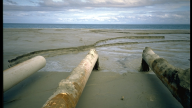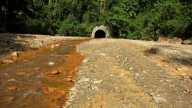Twenty-four years after a catastrophic mine waste disaster on the small Philippine island of Marinduque filled a 26-kilometre river with mine tailings from the mountainous mine site to the sea, Marinduqueños still seek compensation for this disaster from Canadian mining giant Barrick Gold.
The 55,000 residents of the town of Boac, many of whom lost homes, rice fields, animals, and the use of the Boac River for food security and their livelihoods, continue to suffer from acidification and high metal levels in the river that has yet to be remediated.
Today Marinduqueños also remember the many victims, and two children who died, when an earthen dam burst in the town of Mogpog, just three years before the Boac River disaster. That dam was meant to hold back tons of waste from the same copper-gold mine in the mountains. The dam was less than two years old, but when it failed in December 1993, it inundated the Mogpog River with so much metal laden silt that the river left its banks, and houses in nearby villages were swept away. Now, 27 years later, the failed dam does nothing to hold back the tons of waste that remain in the mountains. The Mogpog River is so heavily silted and so acidic that it is devoid of life and causes skin ailments when villagers along the river try to cross it.
The small island province has yet another ecological disaster to mourn, the loss of Calancan Bay. The wide, shallow bay was used as a dumping ground for some 200 million tons of mine tailings from 1975-1991. Families from twelve fishing villages lost their livelihoods and food security as two major coral reefs and seagrasses over some 80 square kilometres of the bottom of the bay were covered. Calancan Bay was also never remediated and remains a source of metal leaching.
The ongoing toxicity of the Boac and Mogpog Rivers will never be resolved until the mine site in the mountains itself is finally rehabilitated and closed responsibly. Both the Tapian and San Antonio open pits have pit lakes that are acidic with environmentally toxic levels of dissolved metals.
In order to avoid overtopping, untreated water from these pit lakes is constantly drained into downstream waterways and polluting them. This needs to stop. Additionally, the large volume of waste rock, tailings and overburden at the mine site needs to be removed, or properly impounded, so that it ceases to threaten downstream ecosystems and communities. Finally, Calancan Bay needs to be rehabilitated and restored as a safe source of food and livelihood for the local fishing villages. It is time for Barrick Gold to step up and work with the people of Marinduque and the national and local governments to finally address this legacy of irresponsible mining and heal the festering wound that is the history of mining in Marinduque.
- See MiningWatch’s “In Commemoration of the Boac Spill”
- 2002 - Placer Dome Case Study: Marcopper Mine (Marinduque, Philippines)
- 2002 - Brief Summary of Findings from Environmental Studies of Calancan Bay related to Surface Disposal Dumping of Mine Tailings into the Bay from the Tapian Pit of the Marcopper Mine
- 2013 - Philippines: Marinduque ‘Pushed to the Wall’ by Barrick Gold









